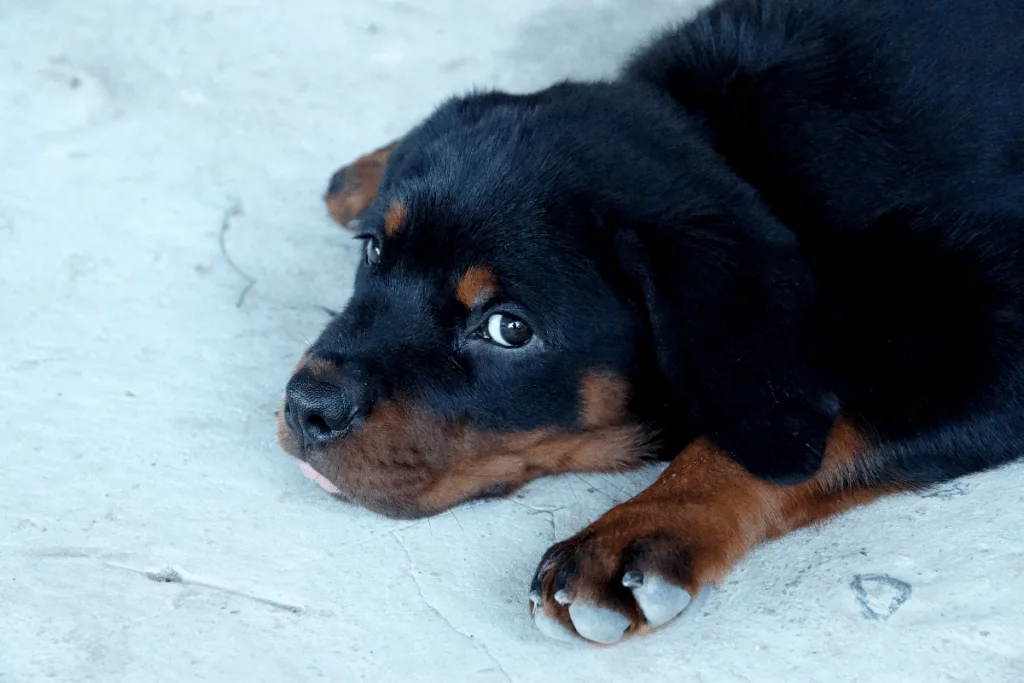
Breeding Rottweilers is not something to be taken lightly because you have a great responsibility to the dogs you are breeding with and all the puppies that are born.
Of paramount importance is knowing how to help the Rottweiler during labor. Pay special attention to the points below:
1) Ask the vet for an estimated litter size. 2) Collect all you will need for the delivery. 3) Prepare a whelping room. 4) Identify signs of labor. 5) Keep the mother calm. 6) Monitor each delivery. 7) Intervene if necessary. 8) Help the puppies. 9) Keep things clean. 10) Watch the mother afterward.
Humans are taken to hospitals or clinics to have their babies, where professionals assist them.
Dogs are only taken to an animal clinic during labor if something is going wrong.
This article is designed to help you if your dog is going to be whelping at home, but you should also speak to a veterinarian in preparation for the event.
Click Here to Jump to a Section
1. Ask The Vet For An Estimated Number Of Puppies
Helping a Rottweiler to give birth starts before the labor does.
The first thing you need to do is ask your veterinarian how many puppies they think your Rottweiler is going to have. They can even do an x-ray to get a better idea.
Knowing the litter size has two main benefits.
Firstly, it helps you to know how many puppies to prepare for in terms of space, equipment, and supplies.
Secondly, and more importantly, you need to be able to tell if labor is over or if there are still puppies stuck in the uterus.
However, you have to understand that this number is just an estimation, even if you have had your Rottweiler x-rayed.
2. Collect Everything You Will Need Before, During, And After The Delivery

Towels
Towels have multiple uses in a whelping room. You can use the towels to:
- Line the floors
- Clean up all the messes
- Wrap around puppies if they need to be rubbed and resuscitated
Newspapers
You will need plenty of newspapers for the delivery and afterward. You cannot just lay down one layer and leave those on the floor through the entire delivery.
Kitchen Paper, Easy Access To Clean Water, And Trash Bags
As mentioned above, there is a lot of mess involved in delivering puppies, so make sure you are well-supplied with kitchen paper. Easy access to clean water is also a must.
You will need at least one trash bag for all the dirty towels that need to be washed and one for the dirty newspapers, kitchen paper, gloves, etc., that need to be thrown away.
Gloves
You will need to purchase a box of medical gloves before the whelping.
You never know what you might be required to do (some possibilities are discussed further on), and you will need to have sterile gloves available.
Kitchen Scale, Notepad, And Pen
As the puppies are born, you should weigh them on the kitchen scale and record their weight and distinguishing features.
Dental Floss
This one may seem like an odd requirement, but you will use it to tie off each puppy’s umbilical cord at the base by their tummy. Do this as soon as possible following their delivery.
The reason for this is because the mother is going to chew the umbilical cord off, but they can sometimes chew it off too short, and then if it is not tied, the puppy can bleed out.
Heater
Even if it is summer, your Rottweiler’s puppies are going to be cold; they are used to being inside a warm body.
Glucose
Glucose can save a puppy’s life if they go into shock after delivery. Ask your veterinarian for the correct dosage.
Puppy Formula
The best option is to have all the puppies drinking from their mother, but sometimes the mother produces too little milk—particularly if it is her first litter—or sometimes the litter is too large for the mother to keep up.
Having good puppy formula on hand before the puppies are born is very helpful because it means if you have to start supplementing the puppies’ diets, then you don’t have to first go out to the shops.
3. Prepare A Room In Which Your Rottweiler Can Give Birth
The room you pick for whelping has to meet specific requirements:
- It must be quiet.
- It must be comfortable.
- It must be warm.
- It must be spacious enough for your big girl to pace if she needs to and for you to move around with her.
- It must not have any steps or any places where puppies can get wedged.
- It must be closed off from the rest of the house and kept free of any other pets.
- It must be where you can hear if something is happening.
- It must be somewhere the mother and puppies can stay for several weeks.
- It must be easy to clean.
Lay down the towels and newspapers, put all of your supplies in the room, set up the heater, and gather bowls of clean water in preparation.
4. Identify The Signs Of Labor
If your Rottweiler stops eating, it can be a sign that she will be going into labor soon.
If you have a rectal thermometer, then you can check her temperature. If it drops to below 100 degrees Fahrenheit, then it can indicate that labor is about to start.
When your Rottweiler goes into labor, she will become increasingly restless and start panting.
She might also lie down in the nesting area you have provided, then get up again, or dig around at the towels on the floor, trying to make a bed.
5. Keep The Mother’s Stress Levels Down

Keeping the mother calm is imperative, especially if it is your Rottweiler’s first litter.
She will likely be very nervous, and it is your responsibility to ensure that everything is as comfortable for her as possible.
This means that even if it is fascinating and very special, and the whole family wants to witness the births, you have to keep the number of people in the room to a minimum, as well as the traffic going in and out.
If your Rottweiler is really not worried, then it is fine; just make sure you do what is best for the mother.
An upset mother can stop actively pushing because she does not feel that the environment is safe for her puppies, which can lead to many problems, including the death of the puppies.
Alternatively, she can reject the puppies when they are born.
6. Monitor The Deliveries
No delivery is going to be the sit-back-and-watch kind. At the very least, you will have to weigh the puppies after they are born (discussed in step eight).
If your Rottweiler is getting the puppies out just fine, then that’s excellent, but if she starts to have trouble, you need to be there immediately.
Someone should always be In the room during the labor.
7. Intervene If Necessary
Once the puppies start coming, they usually come every thirty minutes or so.
So, if it has been more than about forty-five minutes and you know there are more puppies, take her to the veterinarian.
If your Rottweiler looks like she is straining for a while, but nothing is happening, then put on the gloves and, using your finger, gently feel inside the vaginal canal.
If you can feel the puppy, then try gently to grab and wriggle it to help it get loose.
Sometimes, a shoulder is a little stuck, and this is enough to help.
You should take her to the clinic if she is straining and you cannot feel a puppy.
8. Helping And Handling The Puppies Once They Are Born
You may have to help by breaking the puppy’s sac so that they can start breathing. The mother might be too distracted or too tired to do it.
This might not be enough, so you may be required to help the puppy further, especially if they came out backward (more likely to aspirate in this position).
If the puppy is not breathing, open its mouth and use your pinky finger to clear out the mucous.
If this still doesn’t work, you will have to dislodge the fluid from their lungs. Speak to your veterinarian about the correct technique for this.
Puppies can also be resuscitated and be perfectly fine afterward.
Resuscitation involves rubbing the puppy’s body vigorously. Once again, speak to your veterinarian about the best technique.
As they are born, tie off their umbilical cords and record each puppy’s weight, their time of birth, and any distinguishing features to help you track which puppy is which.
You will need to monitor each puppy’s growth in the upcoming weeks, so you need to know the weight at which they started and if they are dropping or gaining weight.
You may have to help the puppies latch onto the mother’s teats. This is very helpful because it releases oxytocin, which increases contractions and assists with the subsequent deliveries of the puppy’s littermates.
9. Keep Everything As Clean As Possible
A lot of fluid is involved in whelping, and you need to keep the area as clean and dry as possible.
Use the spare newspapers and towels to replace the paper as often as necessary. If you can do this between each puppy, that would be great.
If your Rottweiler poops during the deliveries, then clean it up immediately.
Put the dirty papers and towels into trash bags and keep the bags in an out-of-the-way corner of the room.
An afterbirth will be delivered after each puppy. The mother will naturally eat this, but you should consider picking them up before she can do so because eating the placentas can make the mother vomit.
10. Watch The Mother During And After The Deliveries
You will need to watch the mother for shock during delivery.
If she starts to show signs like pale gums, lethargy (beyond physical tiredness from the labor process), etc., then take her to the veterinarian.
Once your Rottweiler gives birth, you will have to monitor her carefully over the next few days to make sure she is healthy because occasionally, a puppy can be retained, and you are not aware of it until the mother gets sick.
Make sure she is eating and that her temperature is normal. You should also watch the vaginal discharge.
Bloody discharge is normal and can last up to a month after birth. However, if it starts to smell or turn green, then take your dog to a veterinarian.
Final Thoughts
Preparation is crucial when your Rottweiler is going to be whelping at home. You cannot be prepared for everything, but you do not want to be taken by surprise with everything.
You also have to be willing to intervene if necessary. You cannot always get your Rottweiler to the veterinarian quickly enough, especially if they go into labor during the night.
Keeping the mother calm throughout labor is also essential, so have as few people present as possible and make sure that there are no other animals around.
And don’t forget, once the puppies are born, the work really starts!
